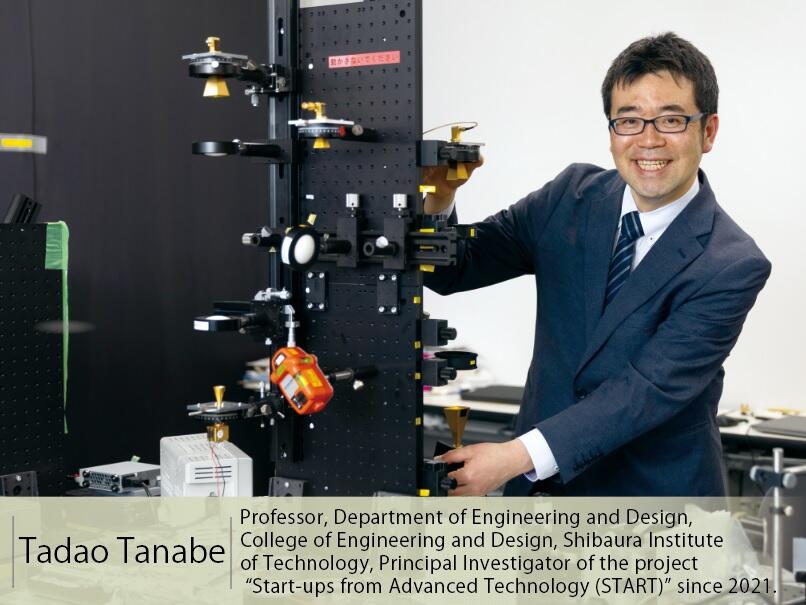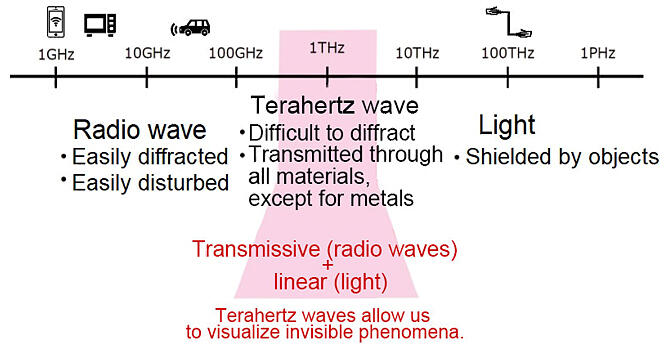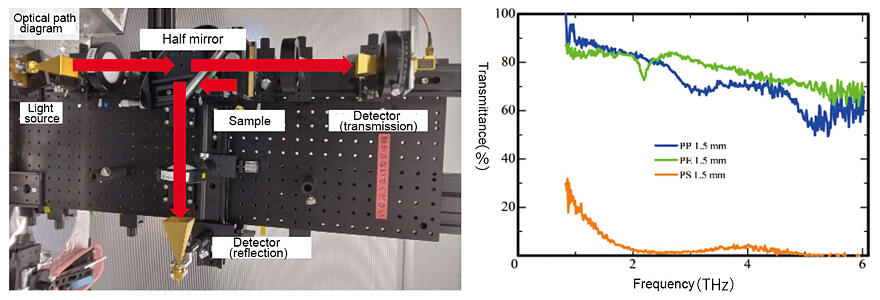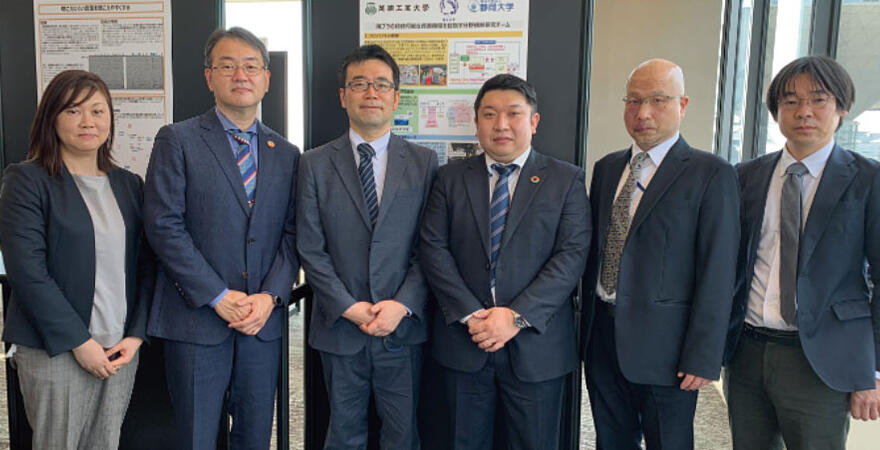This series of articles, "A Look Around Innovation," is being written after visiting research and development sites that are taking on the challenge of innovations that lead to social implementation. In the first installment, we highlight the efforts of Professor Tadao Tanabe of the College of Engineering and Design at Shibaura Institute of Technology in developing a device that uses terahertz waves to efficiently sort a wide variety of plastic waste items. These waves have the properties of both radio waves and light. This device is also aimed at being commercialized as a university-launched venture.

A desire to use visualized terahertz waves in technologies to solve social issues
The 14-story Toyosu campus of the Shibaura Institute of Technology is located in the Tokyo Bay area, where office buildings and condominium towers are also present. The laboratories in the College of Engineering and Design, with glass-walled floors and novel designs of desks and chairs, are attended by several enthusiastic students. This stylish space dispels the stereotype that engineering labs always have a dull appearance with gray walls and visible plumbing.
"The College of Engineering and Design also focuses on solving social problems. We aim to solve social problems of the future by integrating technologies, including materials and systems, into our theme of designing technologies that support urban goods and services. The problem of plastic waste is an important issue facing society," said Professor Tadao Tanabe of the Department of Engineering and Design at the College of Engineering and Design, Shibaura Institute of Technology.
Tanabe began addressing the problem of plastic waste in 2002 when he successfully achieved the oscillation of terahertz waves using semiconductor crystals during his tenure as Assistant Professor at the Graduate School of Engineering, Tohoku University. Terahertz waves have frequencies that are three orders of magnitude higher than those of gigahertz waves used in cell phones. Additionally, terahertz waves have the properties of both penetrating radio waves and linear light (Figure 1). "Terahertz waves allow us to visualize invisible objects. The starting point was seed-based research to determine whether terahertz waves could be applied to solve social problems."
Figure 1: Properties of terahertz waves

The dielectric constants of different materials, including plastics, are different at terahertz frequencies. Thus, plastics can be identified and sorted using these waves.
Through trial and error, this technology has been used in non-destructive testing to examine the interior of electrical wire cables and in spectroscopic devices to identify fiber materials. The researchers have confirmed through their research that the transmission and absorption rates of terahertz waves differ based on the type of plastic used, including the coating materials of electric wires.
Commercial viability confirmed through R&D conducted under SCORE
In recent years, marine pollution due to plastic waste has attracted attention as a global environmental problem; therefore, plastic waste must be appropriately disposed of and recycled for creating a sustainable society. Various types of plastics exist, including polyethylene (PE), polystyrene (PS), polypropylene (PP), and polyethylene terephthalate (PET). If plastics cannot be efficiently sorted, they cannot be recycled and will end up as waste.
Tanabe applied for the Japan Science and Technology Agency's "Start-up Incubation from Core Research" (SCORE) program in 2019 with the aim of advanced identification of plastics using terahertz waves. In this research, by analyzing the transmission and absorption spectra of broadband terahertz waves in the frequency range of 0.5−7 THz, the researchers have proved that the type of plastic such as PE, PS and PP can be identified, and the degradation state of plastics and metal contamination can be determined (Figure 2).
Figure 2: Terahertz transmission and reflection measurement system

The differences in the absorption intensity and characteristic peaks were confirmed by measuring the transmission and absorption spectra of PE, PP and PS (thickness: 1.5 mm) (right).
Additionally, Tanabe visited the sites of recycling companies and traveled to India to assess the present situation regarding the incineration and illegal discarding of plastic waste to recover metals from scrap. He said, "To solve this problem, sorting accuracy must be improved. Single material recycling of PET bottles is well established; however, the sorting rate of PE, PS and PP is only approximately 70 percent, and the applications of these plastics are limited from a quality perspective. SCORE has allowed us to confirm that our advanced sorting system is fully commercially viable."
First goal was developing a 'store-based sorter' — Demonstration tests conducted in a supermarket
In 2021, the project "Commercialization of an Advanced Sorting System for Plastic Container and Packaging Waste" sponsored by the START program was commenced, together with Professor Jeongsoo Yu, Project Assistant Professor Gaku Manago of Tohoku University, and Professor Tetsuo Sasaki of Shizuoka University, with the assistance of the network they cultivated during SCORE. When developing the sorting equipment, they also developed an algorithm for advanced identification using machine learning based on the actual situation at sorting sites where waste is visually sorted by personnel (Figure 3). A prototype machine, which integrates a conveyor belt for transporting mixed plastic waste, and a sorting device, have been constructed and exhibited at trade shows.
Figure 3: Identification of plastic containers and packaging

The response to the working prototype was tremendous. This device was covered by various media outlets, and more than 100 inquiries were received from recyclers and distributors, 26 of whom are in the process of negotiations. The researchers are also planning to start a venture company.
The first goal of the venture company, according to Tanabe, is to construct a 'storefront sorting machine'. "Supermarkets and convenience stores have machines installed to collect PET bottles. Lunch boxes and side-dish containers are made of PE, PS and PP in a variety of colors and shapes. Our advanced sorting machines can sort PE, PS and PP regardless of whether these plastics are transparent or colored and can identify plastics that contain additives that are unsuitable for recycling. We are currently developing a prototype in cooperation with a sorting equipment manufacturer and have commenced demonstration tests at a supermarket. In addition, we are collaborating with other laboratories in the College of Engineering and Design on developing a suitable design for installation in stores to develop a device for practical application."
Tanabe recalls that at SCORE and START, he has been able to interact with several individuals, including experts on urban issues, recycling professionals, and distributors, and his field experience has led to the discovery of new knowledge. In the future, the goal of the researchers is to develop sorting machines applicable to industrial plastic waste and general waste. Additionally, they aim to propose materials, container shapes, and labels that are easily recycled.
(TEXT: Shinji Moribe, PHOTO: Hideki Ishihara)





